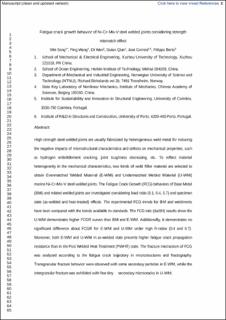| dc.contributor.author | Song, Wei | |
| dc.contributor.author | Wang, Ping | |
| dc.contributor.author | Wan, Di | |
| dc.contributor.author | Qian, Guian | |
| dc.contributor.author | Correia, José | |
| dc.contributor.author | Berto, Filippo | |
| dc.date.accessioned | 2021-06-25T07:55:07Z | |
| dc.date.available | 2021-06-25T07:55:07Z | |
| dc.date.created | 2021-06-22T11:31:06Z | |
| dc.date.issued | 2021 | |
| dc.identifier.issn | 0142-1123 | |
| dc.identifier.uri | https://hdl.handle.net/11250/2761285 | |
| dc.description.abstract | High strength steel welded joints are usually fabricated by heterogeneous weld metal for reducing the negative impacts of microstructural characteristics and defects on mechanical properties, such as hydrogen embrittlement cracking, joint toughness decreasing, etc. To reflect material heterogeneity in the mechanical characteristics, two kinds of weld filler material are selected to obtain Evenmatched Welded Material (E-WM) and Undermatched Welded Material (U-WM) marine Ni-Cr-Mo-V steel welded joints. The Fatigue Crack Growth (FCG) behaviors of Base Metal (BM) and related welded joints are investigated considering load ratio (0.1, 0.4, 0.7) and specimen state (as-welded and heat-treated) effects. The experimental FCG trends for BM and weldments have been compared with the trends available in standards. The FCG rate (da/dN) results show the U-WM demonstrates higher FCGR curves than BM and E-WM. Additionally, it demonstrates no significant difference about FCGR for E-WM and U-WM under high R-ratios (0.4 and 0.7). Moreover, both E-WM and U-WM in as-welded state presents higher fatigue crack propagation resistance than in the Post Welded Heat Treatment (PWHT) state. The fracture mechanism of FCG was analyzed according to the fatigue crack trajectory in microstructures and fractography. Transgranular fracture behavior were observed with some secondary particles in E-WM, while the intergranular fracture was exhibited with few tiny secondary microcracks in U-WM. | en_US |
| dc.language.iso | eng | en_US |
| dc.publisher | Elsevier | en_US |
| dc.rights | Attribution-NonCommercial-NoDerivatives 4.0 Internasjonal | * |
| dc.rights.uri | http://creativecommons.org/licenses/by-nc-nd/4.0/deed.no | * |
| dc.title | Fatigue crack growth behavior of Ni-Cr-Mo-V steel welded joints considering strength mismatch effect | en_US |
| dc.type | Peer reviewed | en_US |
| dc.type | Journal article | en_US |
| dc.description.version | acceptedVersion | en_US |
| dc.source.journal | International Journal of Fatigue | en_US |
| dc.identifier.doi | 10.1016/j.ijfatigue.2021.106389 | |
| dc.identifier.cristin | 1917635 | |
| dc.description.localcode | "© 2021. This is the authors’ accepted and refereed manuscript to the article. Locked until 22.6.2023 due to copyright restrictions. This manuscript version is made available under the CC-BY-NC-ND 4.0 license http://creativecommons.org/licenses/by-nc-nd/4.0/ " | en_US |
| cristin.ispublished | true | |
| cristin.fulltext | postprint | |
| cristin.qualitycode | 2 | |

